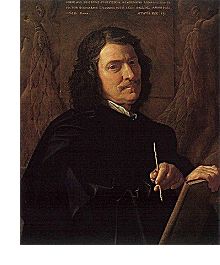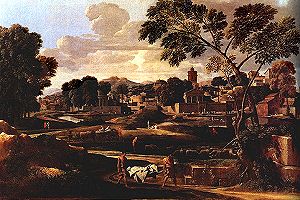
Feature Archive |
August, 2000
Poussin and the Heroic Landscape
| By Joseph Phelan |
 In June, I discussed the rise of landscape painting in Venice, focusing on Bellini and his two great students, Giorgione and Titian. Following in this tradition almost a century later and bringing it to a kind of perfection was a Frenchman who spent most of his adult life in Rome: Nicholas Poussin (1594-1665).
In June, I discussed the rise of landscape painting in Venice, focusing on Bellini and his two great students, Giorgione and Titian. Following in this tradition almost a century later and bringing it to a kind of perfection was a Frenchman who spent most of his adult life in Rome: Nicholas Poussin (1594-1665).As an expatriate in the eternal city, Poussin received commissions from neither the French court nor the Papal one. Nevertheless, he eventually found patrons among a group of clerical intellectuals who taught him about the "glory that was Greece, the grandeur that was Rome." Surrounded by the ruins of this ancient splendor as well as its Renaissance revival, Poussin began one of the greatest artistic encounters of modern times. He studied the canvases of Titian and the compositions of Raphael, originating a painting style of his own capable of expressing the noble themes of epic and dramatic poetry found in Homer, Virgil and Plutarch.
As the first great history painter in Western art who was independent in his choice of subject and approach, Poussin added a score of new themes to the tradition. He showed his originality early in The Death of Germanicus (1626). What make this a landmark in Western painting are the epic theme and the classical design. It introduces a new subject - the hero on his deathbed. (A stunning coup de théâtre from which Jacques-Louis David seems to have learned everything.)
Germanicus was the adopted son of the emperor Tiberius. He was renowned for his victories against the Germanic tribes (hence his name) and the universal affection of his soldiers. Jealous of his success, Tiberius ordered him secretly poisoned. On his deathbed, his soldiers rallied around him and swore to perish rather than leave him unavenged.
Poussin paints the moment just before the captain touches the dying man's hand. In a stunning rectangular frieze running across the painting from right to left, he shows us a full range of human emotions confronting death: the curious younger children ignorant 'till now of mortality, the sorrowful nurse, the inexpressible grief of the wife who conceals her face, and the stoical resolve and adoration of the loyal soldiers. Despite the injustice involved, we are left with a kind of resignation before this good man's fate.
This painting marks the beginning of Poussin's alternative to the dominant trend of the 17th century, the Baroque style. The Baroque style in painting is a vivid, dynamic, powerful one but in the hands of second-rank painters it tends to degenerate into absurd excess for its own sake. In contrast to this, Poussin offered clarity, order, decorum, rest and reasonable limits.
Needless to say, no artist, and certainly no painter of historical, biblical and mythological subjects, can eschew emotion. In fact, Poussin painted scenes of tremendous emotional significance, but always composed them so that we are distanced from the emotional turmoil. Moreover, Poussin was a lover of the landscape around Rome, which he frequently walked through with his neighbor, the other great 17th-century French painter Claude Lorrain. To paint a landscape does not require the bag of tricks used by the Baroque artists. What it does require are joy in the perception, an imaginative sense of the force and mystery of nature, and a feeling for the unifying element of light.
Two of the greatest paintings of Poussin combine his love of antique virtue and his love of landscape. By placing tragic figures in richly interesting and complexly constructed landscapes, Poussin produced two of the most intellectually demanding and satisfying landscape paintings in the Western tradition.
Poussin was drawn to the theme of the perils of virtue and the injustice of power, for reasons which are not hard to understand given his self-imposed exile and his hard won contempt for the prevailing style of art in both France and Italy.
Poussin found in Plutarch the story of Phocion, the most virtuous leader the democratic regime of Athens possessed, and who was indefatigable in his efforts to restrain the excessive adventurism of that democratic regime. For this, the noble incurred the hatred of those elements whose wishes he held in check. When they finally got the upper hand, they cooked up phony charges of treason, voted for his execution, and as a final insult denied him burial in Athens.
 Poussin, an exile himself in Rome, found in this tale a lesson and an inspiration which led to the creation of two of his greatest works. In the first, The Funeral of Phocion, Poussin paints not the trial, nor even the drinking of the hemlock. Instead, he shows us a calm and ordered landscape of unparalleled splendor even for him. In the foreground center we see two men on a melancholy errand hurriedly bearing the corpse of the hero out of the city as if to escape further humiliation. Above this in the center of the painting is a splendid funeral monument of the kind that Phocion deserved. But it belongs to some other citizen - no doubt a very rich one. Meanwhile, to the right of the monument, below the temple, a line of Athenians is engaged in celebrating one of the religious festivals. In keeping with this festive tone, the landscape is brimming with figures engaged in a variety of activities, all of them indifferent to the tragic fate that has befallen Phocion. "What could be more striking", Delacroix wrote in his essay on Poussin, "than this somber vault of ancient trees under which advance the two poor slaves bearing the body of the virtuous Phocion, while the view proceeds in the distance towards the pleasant countryside surrounding Athens, his ungrateful fatherland".
Poussin, an exile himself in Rome, found in this tale a lesson and an inspiration which led to the creation of two of his greatest works. In the first, The Funeral of Phocion, Poussin paints not the trial, nor even the drinking of the hemlock. Instead, he shows us a calm and ordered landscape of unparalleled splendor even for him. In the foreground center we see two men on a melancholy errand hurriedly bearing the corpse of the hero out of the city as if to escape further humiliation. Above this in the center of the painting is a splendid funeral monument of the kind that Phocion deserved. But it belongs to some other citizen - no doubt a very rich one. Meanwhile, to the right of the monument, below the temple, a line of Athenians is engaged in celebrating one of the religious festivals. In keeping with this festive tone, the landscape is brimming with figures engaged in a variety of activities, all of them indifferent to the tragic fate that has befallen Phocion. "What could be more striking", Delacroix wrote in his essay on Poussin, "than this somber vault of ancient trees under which advance the two poor slaves bearing the body of the virtuous Phocion, while the view proceeds in the distance towards the pleasant countryside surrounding Athens, his ungrateful fatherland".In the companion piece, Landscape with the Ashes of Phocion, we see Phocion's widow in the center foreground, gathering his ashes in a similar classical landscape. But we may notice the dark shadows which cloak the wife and her maidservant from view as they go about their devotions. Notice the tension Poussin introduces with this brooding shadow as well as the man spying on them on the right. The sky itself seems to grow dark and ominous with the anger of the gods.
This is an all too frequent tale of human life: the best people are hated and dishonored for their excellence, and finally destroyed and eradicated. Civilization goes on with its manicured lawns, lovely lanes, and its rows of respectable townhouses and temples, intentionally ignorant of what has been done in its name. And yet it is still civilization. In fact the Athenians came to regret their actions and put Phocion's accusers to death a few years later.
Much more could be said about these paintings, not to mention the vast number (220) of other work from Poussin's hand. His will always be a limited appeal, but for those who need order, equilibrium and decorum in their lives, he will always be the master.
Further reading:
Plutarch's life of Phocion "the Good" is online at e-classics.com.
This article is copyright 2000 by Joseph Phelan. Please do not republish any portion of this article without written permission.
Joseph Phelan can be contacted at joe.phelan@verizon.net